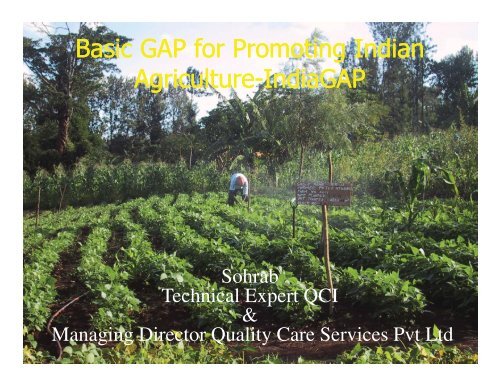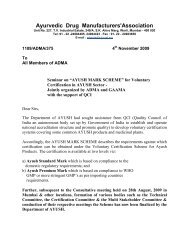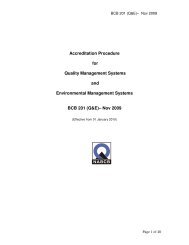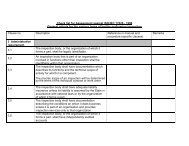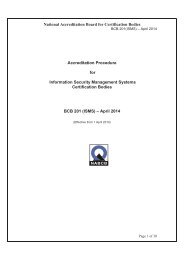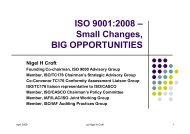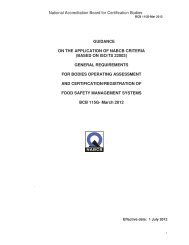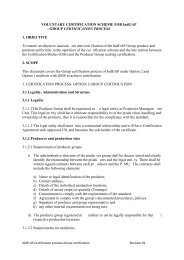Basic GAP for Promoting Indian Agriculture Agriculture IndiaGAP
Basic GAP for Promoting Indian Agriculture Agriculture IndiaGAP
Basic GAP for Promoting Indian Agriculture Agriculture IndiaGAP
- No tags were found...
You also want an ePaper? Increase the reach of your titles
YUMPU automatically turns print PDFs into web optimized ePapers that Google loves.
SohrabTechnical Expert QCI&Managing Director Quality Care Services Pvt Ltd
Moon Light Farming <strong>Agriculture</strong> is as old as human civilization“There was a time when farmers plantedby the phases of the moon and harvestedabout a third or less of the yield they gettoday-if they didn’t lose the crops to weeds,insects, and weather”
Light of the MoonWaxing MoonDark of the MoonWaning Moon
All agricultural production systems and practiceswhich are economically viable, environmentallysound, and socially acceptable ...” “. . . and which contribute to a better quality oflife <strong>for</strong> agricultural producers and their familiesand the general public.”
• Conserves soil and water resources• Maintains a diverse ecosystem• Reduces environmental impacts• Minimizes pest problems• Provides worker safety at work• Produces safe & hygienic produce<strong>for</strong> consumption• It is profitable to farmers
Increasing agricultural productivity&reducing loss Lowering production costs (p/unit) Increasing food safety and quality by: Eradicating worst practices Supporting long term thinking / strategies Optimizing use of natural resources land, water, human capital Enhancing in<strong>for</strong>mation sharing and consensuson “good farming practices” Identifying constraints, institutional supportneeds and interventions to promote <strong>GAP</strong>s
Site History & Site Management Land and Soil management Seed &propagation material management Sowing and crop management Water &irrigation management Fertilizer and nutrient management Integrated pest management Crop produce management
Site history and site managementSite historyAvailability of site records-Flood,famine, rainfallOrderly maintenance and up-to-date recordsReference system <strong>for</strong> each type of farm Site managementRisk assessment <strong>for</strong> each site its suitabilityManagement plan to minimise the risk identified
Land & Soil management Soil mapping Soil map of the farm - soil profile CultivationSoil degradation is a keyfactor in unsustainableproduction systems… Techniques used to improve soil structure to avoidcompaction Application of modern soil conservationtechniques to reduce of soil erosion: mulching cross line techniques on slopes sowing grass or green fertilizers, trees and bushes on borders of sites.
Seed &Propagation Material Management Quality and health of propagation material Guaranty seed quality(free from injurious pests,diseases, virus etc) Documented purchase of propagation material Verification of purchased propagation material Germination quality of seeds Pest and disease resistance varieties Consideration of disease resistance while selectingvarieties Chemical treatments and dressings Records of treatment
Sowing and crop Management Sowing /planting Methods and timings of sowing Records of sowing method, rate and date Genetically modified organisms Application of cultivation techniques to improve or maintain soil structure Proper crop rotation mix cropping
Fertilizer & Nutrient Management Nutrient requirementsEstablish nutrient requirement Application of fertilizers/manures timed Advice on quantity and type of fertilizers Competent and qualified advisors-certificate Fertilizer storage Inorganic fertilizer inventory-record of use Store separate from PPP Store in a clean,dry & covered area -reduce contamination Organic fertilizer Risk assessment Biofertilizer Human sewage sludge banned Inorganic fertilizer Purchased with evidence of nutrient content Evidence of chemical content-heavy metals
Water & Irrigation Management Predicting irrigation requirements Systematic method of prediction Irrigation methods Water conservation Water management plan Record of water usage Quality of irrigation/fertigation water Untreated sewage water banned Annual risk assessment-pollution Water analysis in suitable laboratory
<strong>GAP</strong> recommends three basic principles of IPM:• Prevention-how pests are prevented from entering thefarm,• Observation and monitoring- what are observation andmonitoring techniques used at the farm and• Intervention-how intervention activities per<strong>for</strong>med withouthaving impact of safety and environment.• Training or advice Objective must be achieved with minimum input."IPM is a sustainable approach to managing pests bycombining biological, cultural, mechanical andchemical tools in a way that minimizes economic,health and environmental risks".
Educate growers on the implication of interval ofpesticide use on consumers Scientific basis <strong>for</strong> interval between use of pesticidesand harvest. Producer to demonstrate pre-harvest intervalsobserved <strong>for</strong> PPP applied to the crops, Maintain PPP application records and crop harvestdates from treated locations. Place in the field warning signs, time of applicationetc. to ensure compliance to registered pre-harvestintervals
Plant protection products Management Choice of plant protection products Pre-harvest interval Application equipment Disposal of surplus application mix Pesticide id residue analysis PPP storage and handling Disposal of empty containers Disposal of obsolete PPP
Final produce packing at point of harvest Harvesting process hygiene procedure Documented inspection process Packed produce protected from contamination Collection, storage,distribution point- cleanhygienic Packing material stored to avoid contamination Waste of packing material removed Temperature, humidity control, if stored in the farm Water of potable quality
Produce handling Principles of hygiene Hygiene risk analysis and risk assessment Documented hygiene procedures implemented Personal hygiene Workers basic instruction in hygiene Implementation of hygiene instruction Wearing outer garments Smoking,eating, chewing & drinking at designated places Sign display of instructions <strong>for</strong> workers and visitors Sanitary facilities Clean toilet and hand washing facilities Sign clearly displayed <strong>for</strong> hand washing Lockable storage <strong>for</strong> workers
Produce handling ContdPacking and storage areas? Handling & storage area clean & maintained Storage of cleaning & lubricants Cleaning & Lubricants approved All equipment clean and maintained Rejections and waste- stored at designated place Breakage safe lamps used Written glass and hard plastic handlingprocedure Packing material stored in clean place Restricted animal entry
Produce handling ContdQuality control Documented inspection process Temp. humidity maintained & documented Produce sensitive to light stored away from light Stock rotation managed Verifying measuring & control equipment
Record keeping & internal self assessment Workers health, safety and welfare Waste and pollution Management Environment and conservation Traceability Customer complaints
Record keeping and internal selfassessment Availability of records Retention period defined Minimum internal self assessment or Producergroup inspection per year Effective corrective action on noncon<strong>for</strong>mitiesraised during internal self assessment or producergroup inspection
Workers health, safety and welfare Risk assessmentWritten risk assessment <strong>for</strong> safe & healthy workingTrainingAdequate safety & health Training &records of trainingTraining in first aid<strong>Basic</strong> hygiene training Hazards and first aidAccident and emergency proceduresFirst aids kits availableProtective clothing/equipmentWorkers welfare
Waste and pollution ManagementIdentification of waste and pollutantsIdentify all possible waste productsIdentify sources of pollutantsWaste and pollution action planDocumented farm waste management planFarm and premises clear from litter and wasteAdequate provision <strong>for</strong> waste disposal
Environment and conservation Impact of farming on environment & biodiversity Management of wild life & conservation plan Sustainable commercial activity & environmentalimpact of agricultural activity Baseline audit to understand existing animaland plant diversity Plan to enhance habitats&increase t biodiversityit Unproductive site Conversion of unproductive sites to conservation areas:Low lying wet areasWoodlandsHeadland strip Energy efficiency Monitoring of energy at farms
Traceability & RecalRecall procedure to manage withdrawalRegistered product traceable back to andtractable from registered farmTrackingSupports Logistic ControlTracingRetraces the journey, events & conditions byreference to relevant data and recordsFrom farm to <strong>for</strong>kBatch or LotIdentificationFrom <strong>for</strong>k to farmBatch or LotRecall
Customer Complaints Complaint handling procedure Complaints adequately recorded, studied andfollowed Complainant in<strong>for</strong>med
While FOODQUALITY is anoption ……… FOOD SAFETY isan entitlement.
INDIA<strong>GAP</strong>-STANDARDIZATION
?• An activity giving solution to repetitiveapplications to problems in the sphere ofscience, technology, economics etc aimed at theachievement of the optimum degree of order ina given context• The activity consists of the processes of <strong>for</strong>mulating, issuing andimplementing. standards• Important benefits of standardization are improvement of thesuitability of products, processes& services <strong>for</strong> their intendedpurpose, prevention of barriers to trade and facilitation oftechnological cooperation.
What is a Standard?A technical specification/ other documentavailable to general public, drawn up withcooperation and consensus or generalapproval of all interests affected by it.It isbased on consolidated result of science,technology and experience and is aimed atpromotion of optimum communitybenefits.
Why Standards ?OECD economists found that differingstandards,technical regulations,combinedwith the cost of testing and compliancecertification constitutes between 2 and 10percent of overall production costs -not aninsignificant amount!
• Global upsurge in the use of <strong>GAP</strong> has createdincreased demand of use of scientific agriculture• The major challenge facing growth and outreach of thetraditional agriculture is their quality, safety andsustainability.• The Food Industry is mainly dependentd on the quality ofthe raw agricultural produce used in the manufacture ofthe food product.• In this back ground standardization by QCI/ FASSI toensure quality and safety of raw material <strong>for</strong> foodproducts was initiated
Site selection and meteorological dataSoil conditionsSeeds and propagation materialCrop management <strong>for</strong> cultivationHarvest and post harvest managementIdentification and traceabilityPersonnel and equipmentWorkers health, safety and welfareRecord keeping and internal self-assessment/internal inspection
Method of evaluation• The standard is structured to provide: Control criteria-requirements Con<strong>for</strong>mance criteria-ensuring con<strong>for</strong>mity, Level of con<strong>for</strong>mance: Critical. Major Minor Structured checklist of evaluation provided
Critical:• When evidence shows that the grower has not complied withrequirements in its documentation and implementation and whichraises doubts on the operation and practice of <strong>GAP</strong>calling <strong>for</strong> anearly correction and corrective actions within the time frame.Major:• When evidence suggests major break down in theimplementation in certain elements of the criteria calling <strong>for</strong> theearly corrective actions within a time frameMinor• When evidence shows an isolated non-compliance to the <strong>GAP</strong>criteria and has negligible impact on the operation of the systemand its results.
Certification optionsForIndia<strong>GAP</strong>
Options <strong>for</strong> certificationOption 1 Individual certificationIndividual producer applies <strong>for</strong> certification and gets certification<strong>for</strong> his/her produce.1.1 Multisite without implementation of QMSIndividual producer or one organization owns several productionlocations or Production Management Units (PMU’s) that do notfunction as separate legal entities without QMS applies and getscertification1.2 Multisite with implementation of QMSIndividual producer or one organization owns several productionlocations or Production Management Units (PMU’s) that do notfunction as separate legal entities with QMS applies and getscertification
Options <strong>for</strong> certification1.3 <strong>Basic</strong> Progressive ModelIndividual producer/farmer applies <strong>for</strong> certification and getscertification under the India<strong>GAP</strong> basic requirements.Note-This is generic <strong>GAP</strong> progressive model <strong>for</strong> all farmers and farm produce that arenot able to straight away go to more expressive model of <strong>GAP</strong> given in other optionsOption 2 Group CertificationA producer/farmer group applies <strong>for</strong> group certification and theproducer group, as legal entity, gets certification.


